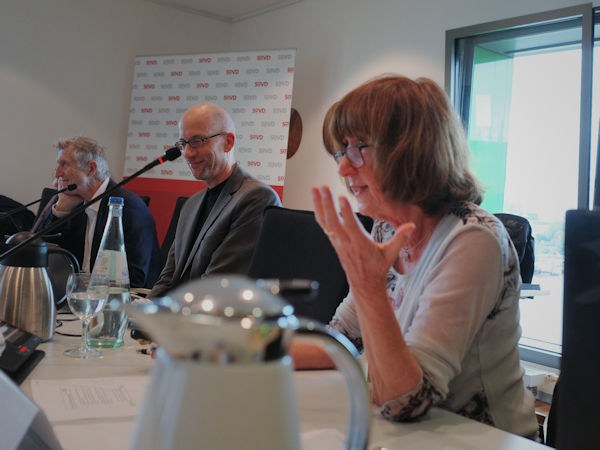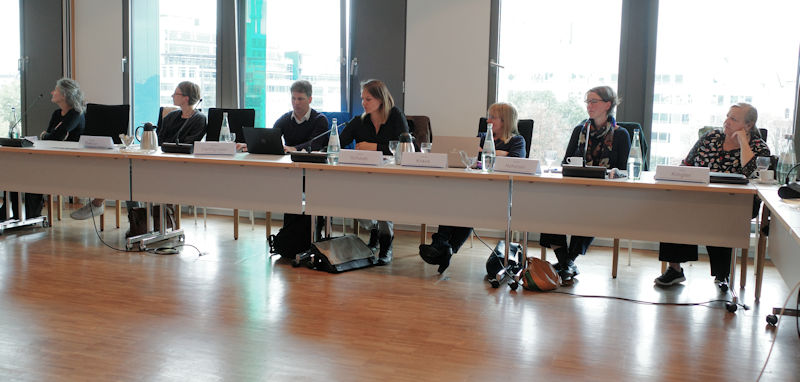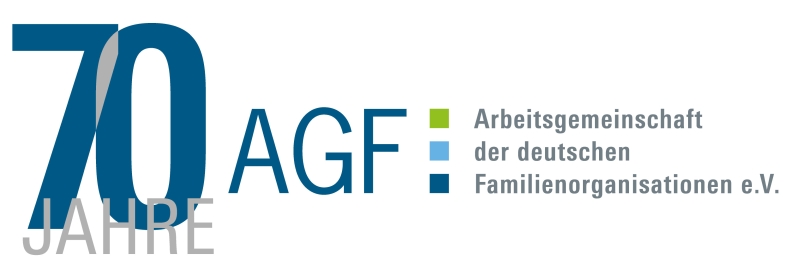The AGF expert discussion discussed various concepts for a better time policy for families. For setting the scene, new data was presented on parents’ wishes regarding the amount of care and paid work and its distribution within the partnership, as well as on the actual use of time by fathers and mothers with young children. The “option time model” was then presented and conceptual considerations of the AGF members for the further development of a life-phase-oriented time policy were discussed.
Presentation of the current FReDA data 2023 on families’ time preferences
Leonie Kleinschrot, Federal Institute for Population Research (BiB) and German Youth Institute (DJI) (Presentation Kleinschrot)
Leonie Kleinschrot compared the time wishes of familes and contrasted them to the realities by using current data from the FReDA (Family Demographic Panel). She emphasized that older studies have already repeatedly described the long-term change in gender role perceptions in Germany, which is expressed, among other things, in a more positive assessment of maternal employment with young children. She added that it was in line with that findings, that compared to previous decades there has been a significant decline in the opinion that men (fathers) should work full-time while the woman should stay at home and look after the household and children. In eastern Germany, only 5% of women and 10% of men agreed with this, compared to 17% and 23% respectively in western Germany.
She stated that it wasn’t not clear whether the changed perceptions were also reflected in a change in parents’ employment behavior. While it was true that the employment rates of mothers have risen continuously in recent years, there still were almost three quarters of parents living arrangements in which the father would work full-time and the mother part-time (working less than 20 hours in around half of these arragnements). This is mainly independent of the age of the youngest child. Overall, parents had a high workload due to employment and care work and half of them felt under time stress.
The FreDA data showed that mothers demands for employment slowly increase from around 20 hours per week when the youngest child is 2 years old to almost full-time when the youngest child is 18 years old. An increase can also be observed afor fathers as their children get older, although the average desired working hours of fathers with two-year-old children are already almost 35 hours. Surprisingly, the fathers and mothers surveyed hardly differed at all in their ideal working hours. This contradicts the frequently expressed desire for a very equal division of paid work and care work between the parents. The FreDA data also showed that the discrepancy between real and ideal working hours is more pronounced for mothers than for fathers.
Accordingly, when it comes to the measures mentioned by parents for a better reconciliation of employment and care work, greater flexibility is at the top of the wish list. In second place, fathers mentioned “working less”, while this was only in ninth place for women. Both mothers and fathers would like to see further measures to make working hours more flexible, companies to become more family-friendly overall and the infrastructure for families to be strengthened.
Presentation of the Option Time Model
Karin Jurczyk, German Society of Time

Karin Jurczyk emphasized that time is considered a crucial prerequisite for a successful family life and studies show that families from all social classes complain about the stress caused by a lack of time. Time conflicts between family care work, employment, but also the need for “time for oneself” may occur throughout family life. This is not only when there are small children in the household, but also, for example, when relatives in need of care have to be looked after.
Karin Jurczyk stated that time problems are different for the genders. Mothers have long been confronted with the expectation of returning to work quickly, without the gender-specific division of labor in care having changed. The welfare state’s framing of employment, which is based solely on the male employment model, which is the model of the male breadwinner who is exempt from care work. Additionally the framing neglects care work which and both framings together continue to lead to the “punishment” of interruptions in employment or reductions in working hours. The attempt to reconcile the contradictory demands of employment and family life leads to gaps in care, lack of time and excessive demands.
The welfare state’s framing of the life course should not only focus on employment in adulthood, but should also take equal account of care work as a social task. The option time model she developed together with Prof. Mückenberger offers a starting point for restructuring towards a life course-oriented and gender-equitable family time policy.
The model offers a nine-year option time budget which should include a total of six years for family care work, two years for personal professional development and one year for self-care. The six years for various private and social care tasks should be distributed flexibly and be available throughout working life. They would be reserved exclusively for care tasks – also in the context of caring for “elective relatives” – and would expire if they were not used.
The option time model provides compensation for the loss of income and pension contributions, etc. Depending on whether the option periods are for care, further training or self-care, a different mode of financing is proposed. Mrs. Jurczyk suggested that the state or the public sector should finance the wage replacement if an option period involves the fulfilment of public interests, such as childcare, caring for relatives or voluntary social commitment. Companies should contribute to the costs by continuing to pay wages if professional qualifications are acquired or other benefits accrue to the company or the economy. Where it is exclusively in the employee’s own interests, the option period should be financed through savings and borrowing.
Mrs. Jurczyk sees the option time model as a contribution to the discussion about the necessary transformation of the economy and society to overcome the care crisis and to promote a fairer distribution of care work. However, the concretization of the model and its implementation now requires the knowledge of other stakeholders. The aim of the “Option time model labatory” project, which is now being launched, is to involve these actors, in which various stakeholders are to contribute their expertise to the development of implementation perspectives.
Assessments of the AGF member associations
The AGF member associations reported on the current status of their time policy discussions. Svenja Kraus from the evangelische arbeitsgemeinschaft familie (eaf) referred to her concept of “dynamic family working time” (https://www.eaf-bund.de/sites/default/files/2022-12/221212_Auszug_FPI_4_2022.pdf) presented last year. This refers to parents with children before school age, as this is where the eaf sees the greatest need for action in terms of time policy. The aim of the concept is to promote the equal sharing of family and paid work between fathers and mothers. Dynamic family working time is not primarily aimed at getting parents with young children into full-time jobs, but rather wants to focus on the time use wishes of mothers and fathers and reduce the discrepancy with the actual time use patterns.
Matthias Dantlgraber reported that the time policy discussion in the Family Federation of Catholics (FDK) is looking for models that do justice to all families. There must also be time policy measures for families who prefer a classic asymmetrical division of labor between the sexes. To this end, there should not be a rigid model in legislation regarding the division of paid work and care work within the family. The FDK therefore advocates, among other things, greater recognition of care work in social insurance and pensions. In its opinion, time policy models must also include offers for families who want a traditional division of labor.
Maria Ringler from the Association of Binational Families and Partnerships, iaf, reported that her association does not yet have a fully formulated time policy model. However, in the option time model presented, there were many similarities with the fundamental perspectives of the iaf regarding solutions to the time constraints of families. From the iaf’s point of view, however, there is a need to take greater account of the specific situation of families with a history of migration, their situation on the labor market and other barriers to time policy measures. It is also necessary to reflect on how the implementation of desired goals can also be culturally supported.
Iris Emmelmann pointed out that the German Family Association (DFV) places the freedom of choice of families in the division of employment and care work at the center of its considerations. The DFV’s thoughts on the design of time policy concepts were in line with those of the FDK. From their point of view, too, there should not be any political dictation of life models. The DFV currently sees the priority in the further development of existing instruments such as parental leave and the improvement of the situation of family carers, for example by increasing the care allowance to the maximum level of reimbursement for outpatient services.
Miriam Hoheisel reported that the Association of Single Mothers and Fathers (VAMV) had not yet developed its own time policy model either. However, the VAMV also supports the goal of a new balance between paid work and care work and the promotion of a more gender-equitable division of both forms of work. With regard to the option time model, she added that the planned six years of leave for care work for children and dependents in need of care were geared towards two-parent families. Single parents would need double the time off for childcare, so that the six years would have to be adjusted upwards for this group.
Sophie Schwab emphasized the discrepancies between work wishes and working time realities for the Progressive Family Forum (ZFF) and focused on the question of what needs to be done in addition to monetary incentives to bring them closer together. The aim should be for fathers and mothers to be able to take on equal family responsibilities without jeopardizing their independent social security. Opportunities to reduce working hours or take temporary leave to take on care work must be created across all family phases. This also requires a good and flexible care infrastructure. The ZFF, like other participants in the expert discussion, is committed to these goals in the alliance “Sharing care work fairly”.

Discussion
In the discussion, some participants formulated the goal of changing the dominant employment model. This could only be achieved by changing the labor and socio-political framework that creates the “typically male” and “typically female” employment and time patterns that prevail today. However, “smaller” political initiatives such as the introduction of the latest proposal of a “family start time” after birth could also help to promote a more gender-equal distribution of paid work and care work. This should be explicitly communicated as a “father’s issue” in order to increase the effect on men taking on care work. The restructuring of parental leave, as proposed in the last family report, could also contribute to this.
The question of how to successfully support a change in gender roles that establishes care work as the norm for all genders was also discussed. Social norms follow not only material incentives, but also cultural patterns. Therefore, changes are needed both in the labor and socio-political framing of employment and care biographies as well as in the dominant images of masculinity and femininity.
Some participants already saw an approach to change in the fact that fathers want to reduce their weekly working hours while mothers want to increase them. It was pointed out that change is not only underway on the family side. Due to the growing shortage of skilled workers, companies are also becoming more open to a family-friendly company culture and more accepting of family-friendly working hours and men’s desire to work part-time. Companies are increasingly responding to the fact that mothers and fathers want to work less during the family phase.

